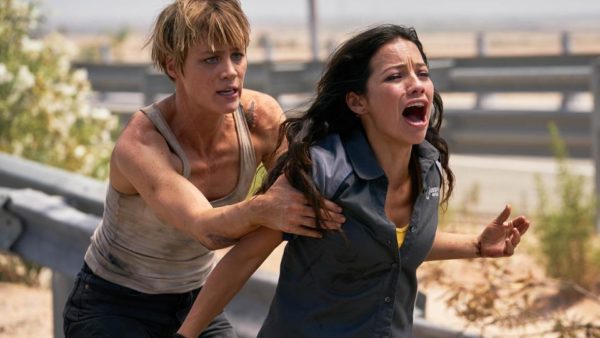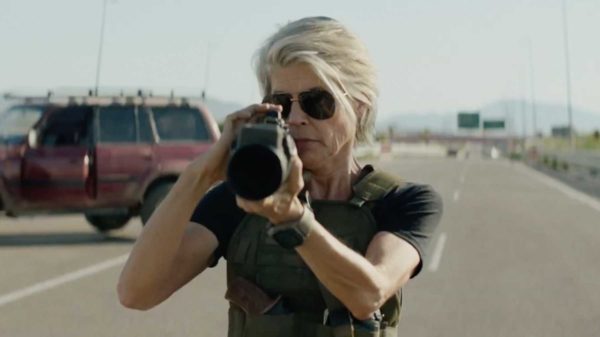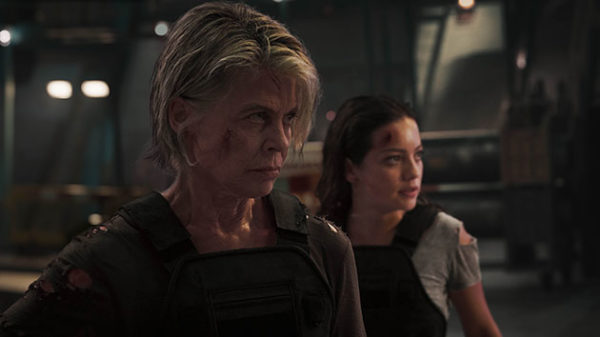
Terminator: Dark Fate may not be blowing up the box office, but there’s a reason why it should be at the top of your Must-Watch list.
The Plot: Taking place in the aftermath of Terminator 2, Grace (Mackenzie Davis), an augmented human from the future, is sent back in time to present day Mexico City to protect car factory employee Dani Ramos (Natalia Reyes) from shapeshifting Terminator, Rev-9 (Gabriel Luna). After a new escape with Dani’s brother, Diego (Diego Boneta), they meet up with Sarah Connor (Linda Hamilton) and embark on a mission to protect the future of humanity with the aid of an old friend…or foe (Arnold Schwarzenegger).
Mild spoilers follow…
What Doesn’t Work: Let’s begin with the bad news first because overall Terminator: Dark Fate is actually really solid. The advertising for the film leaned hard on the nostalgia element by emphasizing the film’s (surprisingly infrequent) callbacks to the first two films, including T2‘s iconic freeway chase scene, as well as the return of Hamilton and Schwarzenegger. Unfortunately the advertising – shockingly – isn’t an accurate representation of the final film, which despite following a similar narrative trajectory, still manages to introduce enough new elements to justify its own existence.
If there is one major gripe to be had, it is that the film overstays its welcome. The 128 minutes runtime is in keeping with the franchise, but for the purposes of the film, Dark Fate is arguably (at least) one action scene too long. The plane battle glimpsed briefly in the trailer is the high point of the film, but there’s actually another brief tussle at the top of a dam before the final climax takes place in the dam’s deserted power station.
Considering the suspension of disbelief required to get through the plane battle, which is simultaneously entertaining and ridiculous, the addition of yet more action can be a bit taxing. The film feels like it’s ramping up, then it ramps up some more and then one final time, which is a touch exhausting.
Finally, Reyes is solid, albeit unspectacular for the majority of the film. Davis and Hamilton more than make up for her meekness, which – as a civilian – makes perfect sense, but Dani is less of a presence than Chosen One characters from the earlier entries. She does get her expectedly heroine moment in the climax, but it comes a touch late.
More specific spoilers follow…

What Does Work: Let’s address the film’s single greatest asset right off of the top: its progressiveness. This is the first entry in the franchise that directly tackles race and it automatically adds a completely new element to the mix. Screenwriters David S. Goyer, Justin Rhodes and Billy Ray and director Tim Miller make a series of very deliberate decisions to place POC and women at the center of the narrative. The saviour of the human race is a low income Mexican woman (important note: Reyes is actually Colombian, not Mexican) and her two main protectors are women, one of whom is 63 years old (Hamilton is unquestionably the film’s MVP: she’s tough, abrasive and drops F-bombs like nobody’s business. She is the coolest).
Yes, Arnold eventually comes into the mix (both he and Hamilton are principals; these aren’t mere cameos), but even with his presence, it’s crazy to consider this $185M franchise film is anchored by a POC lead, a POC villain, a buff AF female lead, and two actors pushing seventy.
The progressive element goes beyond casting, too. Dani’s job at an automobile factory initially seems designed to bolster American concerns about losing jobs to developing countries, but Diego’s job is being outsourced (by their white boss) to a robot. This is doubly ironic given that it’s a Terminator film, but also become this brief plot development slyly realigns audience sympathy onto the Ramos family, who are presented as hard-working employees who deserve better treatment. This is in keeping with the film’s larger thematic message about humanity overcoming their differences to come together in the face of a new AI threat.

Later, after Dani goes on the run with Grace and meets up with Sarah, the trio must make their way to Texas. They hop aboard a freight train loaded with transient people who welcome them with food and mind their own business. There’s a quiet dignity to these scenes, which offer levity and character development for all three women, who must learn to trust each other despite their differences.
Eventually Dani’s uncle, a coyote, helps secure them passage under the wall separating Mexico and the US, while the Rev-9 abuses the military’s power to track them using a drone and infrared technology. He deliberately misconstrues their dangerousness so that they are met by an overwhelming force on the American side and taken into custody at a detention center. There they are kept in gated cells that have been packed full (this set also looks much clearer than the pictures of real life detention centers).
When the Rev-9 stages an attack, Grace – who has been taken to an infirmary – demands to know “where the new prisoners are taken”. The guard responds by sheepishly correcting her: “we call them ‘detainees.'” It’s a hilariously absurd moment in the middle of a major action sequence, the inclusion of which is a damning indictment of the semantics used by the American military to justify their inhumane treatment of non-white people.
Terminator: Dark Fate is chock full of these kinds of moments, making for a big budget Hollywood film that routinely comments on (and criticizes) contemporary US politics.

The Bottom Line: The truth about Dani’s role in the future, her relationship with Grace (glimpsed in flashbacks flash forwards), the focus on mentorship instead of motherhood and the begrudging acceptance between Grace and Sarah (two generations of female strength) makes this an unequivocally feminist film. The narrative centering around a Chosen One who is protected by a warrior from the future and outgunned by a stronger opponent offers familiar tropes of the franchise going back more than three decades, but Terminator: Dark Fate is much more ambitious.
Yes, this is unabashedly a big, dumb action film, but it’s also a stunningly progressive film that completely shifts the typical Hollywood narrative to privilege an illegal immigrant POC as the most important woman in the world.
For 2019, that’s fucking revolutionary.
4DX Review: I was lucky enough to catch the film in immersive 4DX, which involves experiencing the film as much as viewing it. (For comparison’s sake, my favourite 4DX experiences to date have been Mission: Impossible: Fallout and Aquaman)
Terminator: Dark Fate is equal to MI: Fallout in that it offers a diversity of sensory experiences: an underwater sequence at the dam, the aforementioned rotating topsy-turvy air battle and the extended freeway chase. That last sequence perfectly aligns the thrills of 4DX (shaking chairs, back-punching impact simulation, air whistling past the ears for bullets) with the onscreen action.
I will confess that I expected a touch more watery mist-spray during the dam sequence (the best blast is, hilariously, when Dani shoots a watermelon during target practice), but considering how action-packed Terminator: Dark Fate is, the 4DX experience well worth the extra expense.
Terminator: Dark Fate is now playing in theatres.